Microsoft .NET version 4.8 comes preinstalled with the Windows 10 May 2019 Update (Version 1903) or Windows Server 2022. If you have installed the product in a system running below these versions, make sure that you have Microsoft .NET version 4.8 and PowerShell version 5.1 installed.
reg query "HKEY_LOCAL_MACHINE\SOFTWARE\Microsoft\NET Framework Setup\NDP\v4\full" /v version
$PSVersionTable
You must be using 32 bit version of M365 Manager Plus. Windows Azure Active Directory Module v2 (AzureAD) must be installed to manage and generate reports on Azure Active Directory, which is not available in 32 bit version.
Hence follow the below mentioned steps,
Download and install M365 Manager Plus (64-bit)
To install Azure Active Directory Module v2 (Azure AD):
If MicrosoftTeams module is not installed, you will not be able to view any general reports on Skype for Business.
Note: PowerShell version 5.1 or higher is required to install MicrosoftTeams PowerShell module.
Steps to download and install MicrosoftTeams Module.
To check if the module is installed, open PowerShell and enter Get-module -ListAvailable -Name MicrosoftTeams. If MicrosoftTeams module is already installed, it will be listed in the result. If not, run the below PowerShell command in as an administrator,
Install-Module -Name MicrosoftTeams -Force;
After installing the module, please restart the application.
You must be using 32 bit version of M365 Manager Plus. MicrosoftTeams, which is required to generate reports on Skype for Business is not available for 32-bit version.
To resolve this issue,
Download and install M365 Manager Plus (64-bit)
Follow these steps to install MicrosoftTeams module.
After installing the module, please restart the application.
Microsoft retired all the earlier versions of the Microsoft Teams PowerShell module from June 15, 2022. Only the module versions present in the 4.x.x series or later are supported now. Therefore, it is recommended to update the Microsoft Teams PowerShell module to the latest version available for smooth functioning of the product.
Follow the steps below to update the Microsoft Teams PowerShell module:
Run the PowerShell command below as an administrator on the machine where the product is installed:
Update-Module -Name MicrosoftTeams -Force;
Once the module has been updated, please restart the product.
If the problem persists please contact m365managerplus-support@manageengine.com.
For General Skype reports, Microsoft .NET framework version 4.8 or higher is required.
reg query "HKEY_LOCAL_MACHINE\SOFTWARE\Microsoft\NET Framework Setup\NDP\v4\full" /v version
Check the displayed version. If the version is below 4.8, install Microsoft .NET Framework version 4.8 from here.
The product requires an active internet connection to interact and function as desired. Please make sure that your internet connection is active and stable.
PostgreSQL
The backup fails due to one of the following reasons.
If the problem still persists please contact m365managerplus-support@manageengine.com.
MSSQL
The backup fails due to one of the following reasons.
If the problem still persists please contact m365managerplus-support@manageengine.com.
Elasticsearch is a distributed search engine which helps to analyze huge volumes of data in near real-time. Unlike conventional techniques, Elasticsearch fetches data real quick which results in reduced report generation time, quicker threat detection, and a lot more. In M365 Manager Plus we use Elasticsearch in the following modules,
Recommended:
It is advised to have at least 1 GB free hard disk space for Elasticsearch to function effectively. If the disk space runs low, Elasticsearch will be switched to read-only mode, during which the data collected from native will not be stored in the engine. To enable Write for Elasticsearch,
For General Skype reports, Microsoft .NET framework version 4.8 or higher is required.
reg query "HKEY_LOCAL_MACHINE\SOFTWARE\Microsoft\NET Framework Setup\NDP\v4\full" /v version
Check the displayed version. If the version is below 4.8, install Microsoft .NET Framework version 4.8 from here.
You must be using 32 bit version of M365 Manager Plus. MicrosoftTeams, which is required to generate reports on Skype for Business is not available for 32-bit version.
To resolve this issue,
You will see one of the following conditions if tenant configuration is incomplete.
If the REST API Access column shows Enable Now:
Cause
If the REST API Access column shows Update Permissions:
Cause
If the REST API Access column shows Grant Admin Consent:
Cause
Solutions
Note: Follow the steps in this document to grant the required permissions for REST API access.
Cause
Solution
Cause
Solution
Cause
Solution
Cause
Solution
To test the connectivity of your Microsoft 365 environment using PowerShell, follow the steps listed here.
Make sure that the report corresponding to the graph can be generated without any issue for the specified number of days.
If the report cannot be generated, follow the troubeshooting tips listed based on the cause of error.
If the report can be generated but the graph in the dashboard does not mirror the values, contact m365managerplus-support@manageengine.com .
Make sure that you have entered the correct user name and password.
Check if the user account is blocked. To check if an account is blocked, follow the steps listed here.
Check if the required roles are assigned to the service account. Click here to view the list of required roles.
Run the Office365Troubleshoot.ps1 script file
Note: <install-dir> here refers to the directory in which you have installed the M365 Manager Plus application.
Make sure that you have entered the correct user name and password.
Run the Office365Troubleshoot.ps1 script file
Note: <install-dir> here refers to the directory in which you have installed the M365 Manager Plus application.
Please check if you can log in to the Microsoft 365 portal with the user account.
Reset the account password and try again.
Please check if you can log in to the Microsoft 365 portal with the user tenant.
Check if the user account is blocked. To check if an tenant is blocked, follow the steps listed here.
The error occurs when a PSSession can not be opened successfully.
Run the Office365Troubleshoot.ps1 script file
Note: <install-dir> here refers to the directory in which you have installed the M365 Manager Plus application.
Run the Office365Troubleshoot.ps1 script file
Note: <install-dir> here refers to the directory in which you have installed the M365 Manager Plus application.
Make sure that you have entered the correct user name and password.
MicrosoftTeams module does not support App Password. If the Service Account is MFA-enabled, please provide the account password.
The Microsoft 365 authentication system may be not functioning properly. Please try again after some time.
Click Tenant Settings option found at the top right corner.
Choose the correct Azure cloud environment from Azure Environment drop-down.
Note: <install-dir> here refers to the directory in which you have installed the M365 Manager Plus application.
The following reports require Unified Audit Log to be enabled:
To enable the collection of Unified Audit Log data, follow the steps mentioned below.
Enable collection of unified audit log data through Microsoft Purview.
To generate audit reports for all operations, follow the steps listed below.
Note: <install-dir> here refers to the directory in which you have installed the M365 Manager Plus application.
Get-Mailbox -ResultSize unlimited |Set-Mailbox -AuditEnabled $true -AuditOwner Create,HardDelete,MailboxLogin,Move,MoveToDeletedItems,SoftDelete,Update -AuditAdmin Copy,Create,FolderBind,HardDelete,MessageBind,Move,MoveToDeletedItems, SendAs,SendOnBehalf,SoftDelete,Update -AuditDelegate Create, FolderBind, SendAs, SendOnBehalf, SoftDelete, HardDelete, Update, Move, MoveToDeletedItems
Set-Mailbox -Identity abc@microsoft.com -AuditEnabled $true -AuditOwner Create,HardDelete,MailboxLogin,Move,MoveToDeletedItems,SoftDelete,Update -AuditAdmin Copy,Create,FolderBind,HardDelete,MessageBind,Move,MoveToDeletedItems, SendAs,SendOnBehalf,SoftDelete,Update -AuditDelegate Create, FolderBind, SendAs, SendOnBehalf, SoftDelete, HardDelete, Update, Move, MoveToDeletedItems
Get-Mailbox -ResultSize unlimited |Set-Mailbox -AuditEnabled $true -AuditOwner Create,HardDelete,MailboxLogin,Move,MoveToDeletedItems,SoftDelete,Update -AuditAdmin Copy,Create,FolderBind,HardDelete,MessageBind,Move,MoveToDeletedItems,SendAs, SendOnBehalf,SoftDelete,Update -AuditDelegate Create, FolderBind, SendAs, SendOnBehalf, SoftDelete, HardDelete, Update, Move, MoveToDeletedItems
Identify the operations that you want to be audited from the underlined section and exclude the rest from the script.If any of the generated reports under users or mailboxes section do not contain information for certain individuals, then follow the steps listed below.
To rectify this, purchase more licenses or reassign licenses to accommodate the user by following the steps listed below:
Cause
This error occurs when:
Solution: Update REST API permissions with the following steps.
This account has been blocked by the administrator.
Contact your administrator to login to M365 Manager Plus.
This message indicates that,
The data for this report is currently being generated in the background for some other report opted by you.
Or the data is already being generated in the background by some other user.
Note: If the data generation was successful in either of the above mentioned cases, it will be updated automatically. Hence try switching to any other report and check the required report at a later time.
Click Tenant Settings option found at the top right corner.
Choose the correct Azure cloud environment from Azure Environment drop-down.
Cause
Solution
Cause
Solution
Steps :
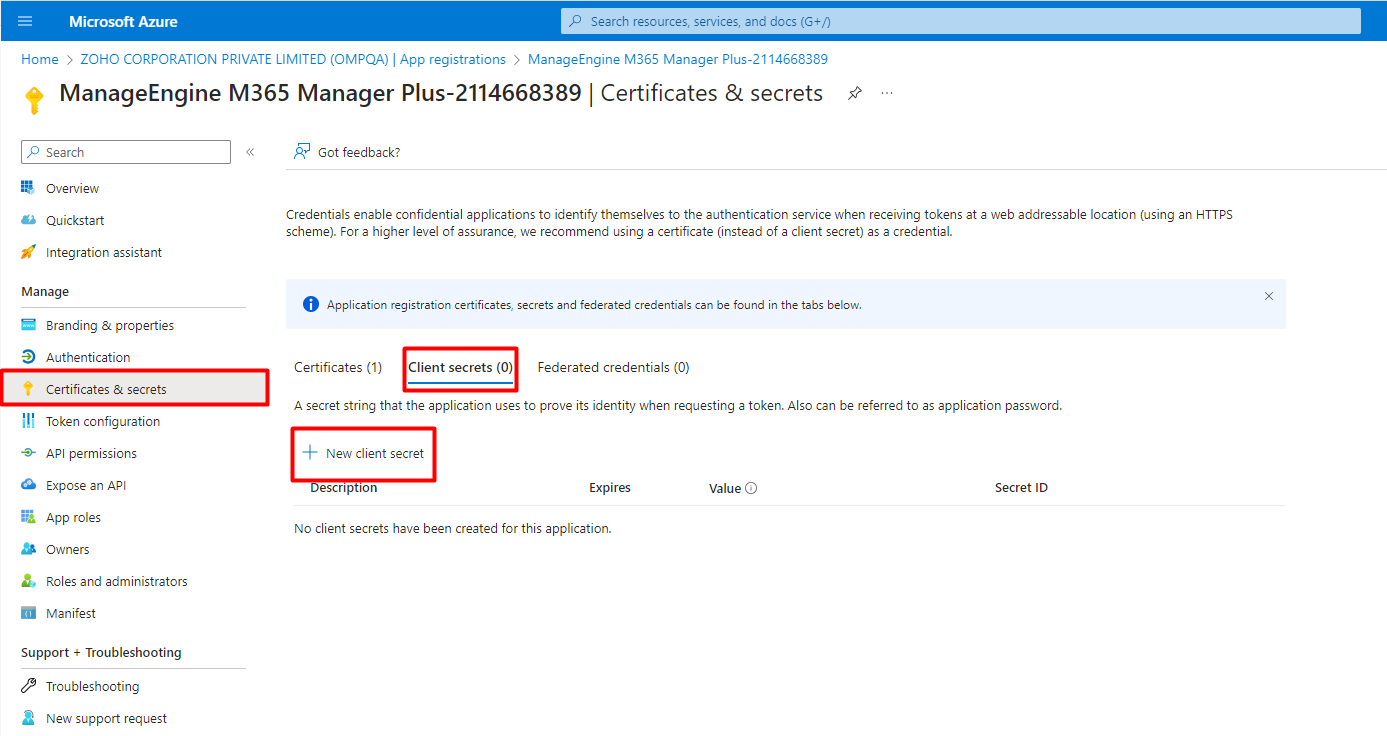

Cause
Solution
Note: A newly configured application might take some time to reflect the change in permissions. Please wait for some time or refresh the tenant by clicking on Tenant Settings and click on ![]() icon under the Actions column of the tenant to be refreshed
icon under the Actions column of the tenant to be refreshed
If the issue still persists, please contact m365managerplus-support@manageengine.com.
Error: Identifiable user information hashed in M365 Manager Plus reports.
Solution: Due to Microsoft's privacy settings, identifiable user information may appear hashed in M365 Manager Plus reports. Follow the steps below to show identifiable user information in reports.
Note: Please note that the changes will automatically reflect in the product only after the next report sync.
To perform manual sync, go to Product scheduler > DefaultRestAPISync > Run now.
Error: The cache is being updated. Please try generating the report again after a few minutes.
Cause: Frequently accessed data is updated in the cache for faster report generation. This message appears due to one of the following reasons:
Resolution: Wait a few minutes and try again to generate the report.
The speed of report generation is increased by using the cache memory. While generating reports, cache initialization might fail if the cache folder does not have the required permissions. Follow these steps to grant required permissions to the cache folder.
These steps will grant the required permissions to the cache folder in <product_installation_directory>/mmp/cache. If the issue persists, please contact m365managerplus-support@manageengine.com.
ManageEngine M365 Manager Plus uses these applications in Azure AD to fetch data for report generation and other tasks:
Apart from the above mentioned applications, users would have to create an application that needs to be configured to M365 Manager Plus.
When the administrator disables access to these applications, report generation will fail and users will face this error.
To resolve this error, Azure AD application access must be enabled for all users.
Note: Only an administrator or a user with appropriate permissions can enable access.
To enable Azure AD application access:
To install the latest MSOnline module:
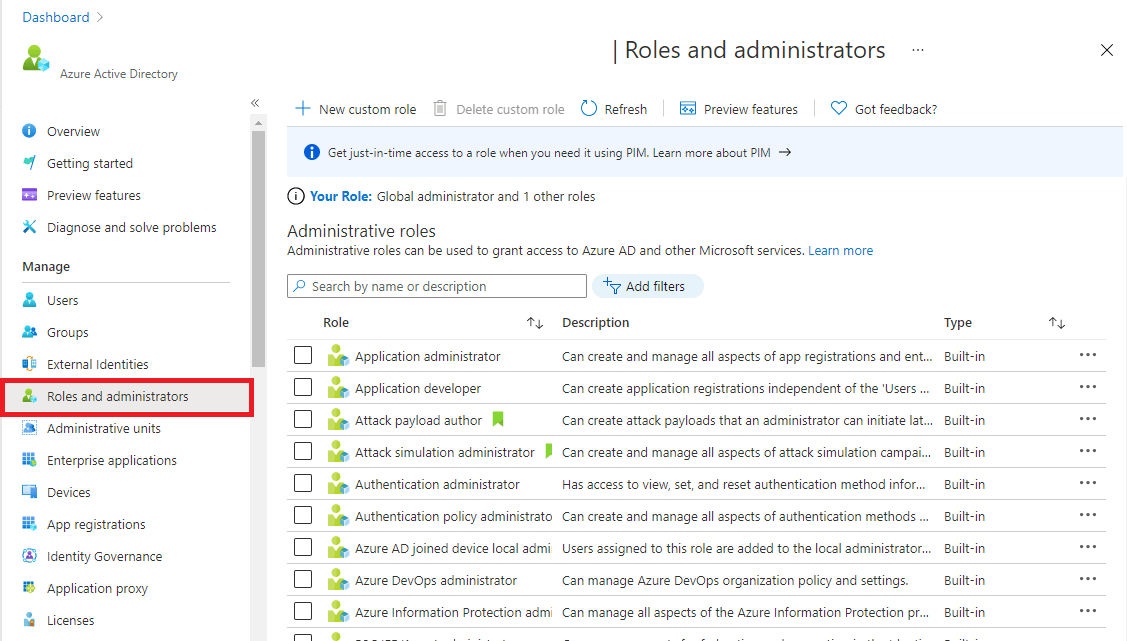
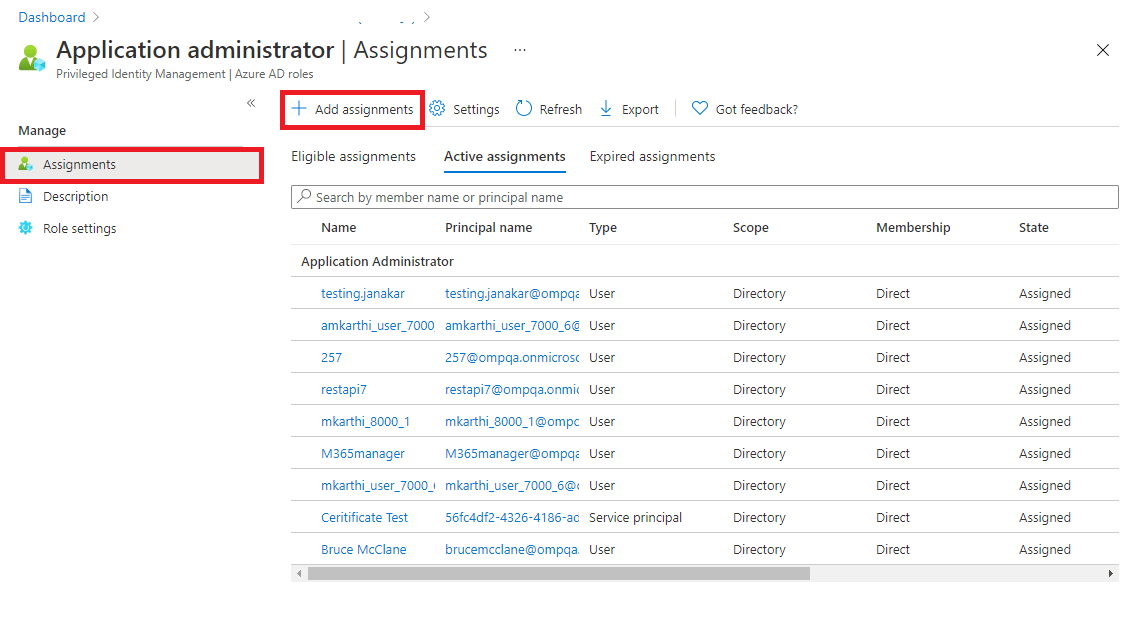
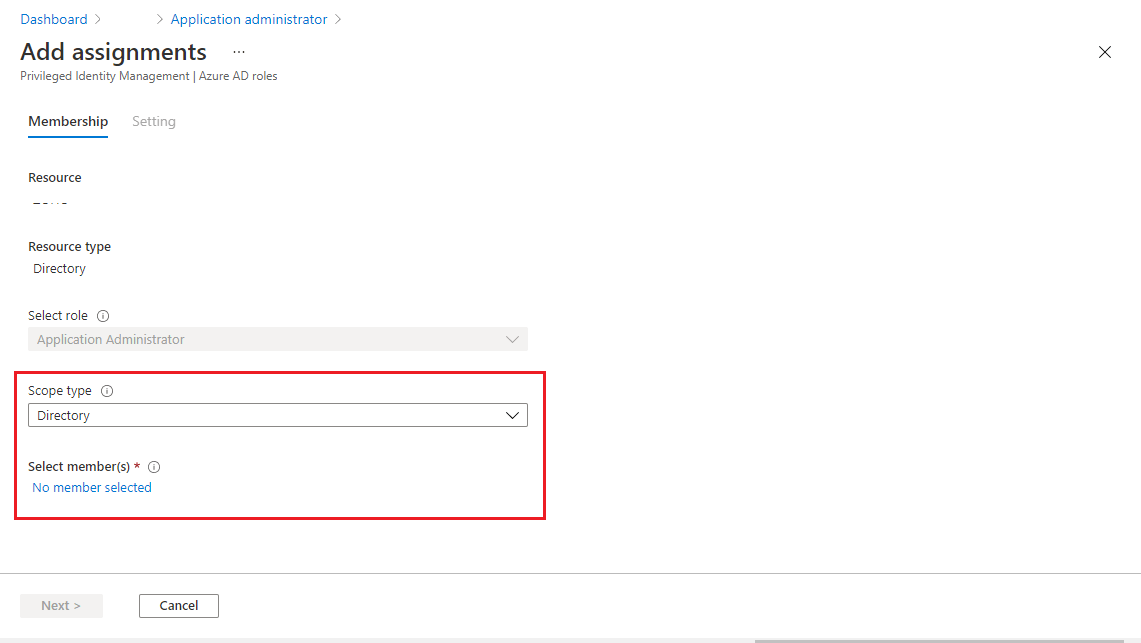
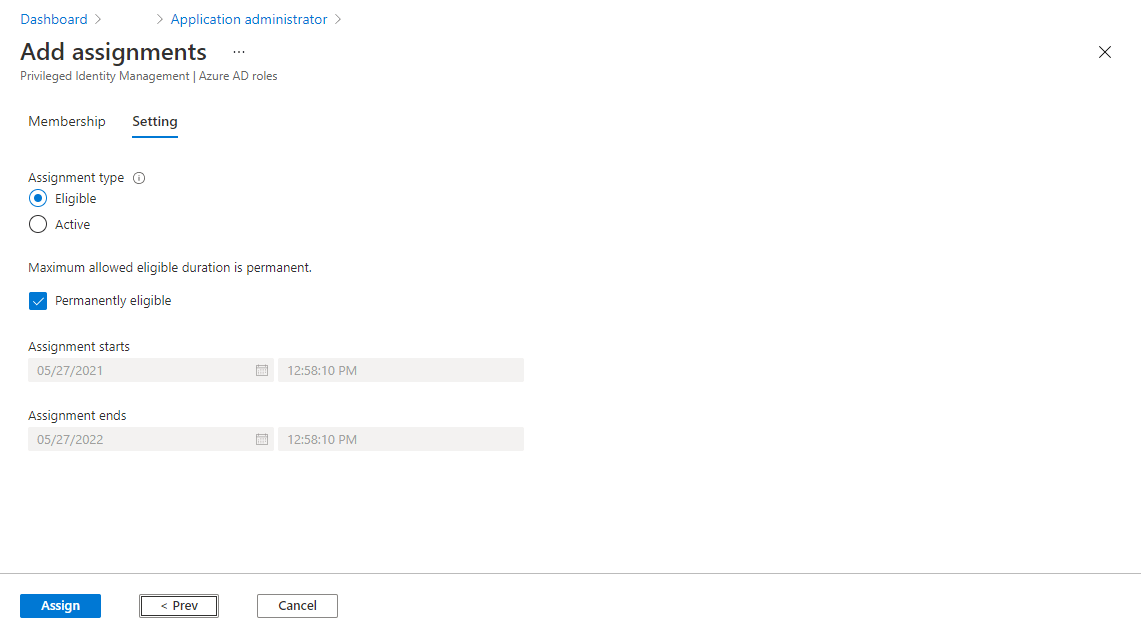




If basic authentication is disabled, the user will not be able to run Exchange-related activities through PowerShell scripting. In such cases, reports or management tasks will fail to execute. To turn on basic authentication in WinRM, open an elevated Command Prompt and run:
If Basic = true is not found, run the below command:
Or,in elevated PowerShell, run the below command to modify the Windows registry:
For more details, please refer to this document.
Please check your internet connection.
Enable TLS 1.2
M365 Manager Plus uses .NET framework to connect to Microsoft 365 and collect the required data. Since TLS 1.0 and TLS 1.1 have been deprecated for security reasons, Microsoft 365 fails to connect with clients that use these two versions. Deprecated TLS versions will be used only if an older .NET version is used or if the older TLS versions are manually enabled. As older .NET framework won't use the latest protocol (TLS 1.2); a manual update of the registry is required.
Execute the following PowerShell script in Run as Administrator mode in the machine in which M365 Manager Plus is installed to enforce TLS 1.2:
Run the Office365Troubleshoot.ps1 script file
Note: <install-dir> here refers to the directory in which you have installed the M365 Manager Plus application.
If your certificate has expired or not registered or removed from portal, add a new one using the following steps.
Note:If the issue still persists, please contact m365managerplus-support@manageengine.com.
Cause
This message is shown when you try to generate any of the following reports in a tenant without a Microsoft Entra ID P1 or P2 license:
Solution
To resolve this, make sure your tenant has a Microsoft Entra ID P1 or P2 license.
This indicates that a subscription within the tenant has lapsed or that the administrator for this tenant has disabled the application, preventing tokens from being issued for it.
Note: Only an administrator or a user with appropriate permissions can enable access.
To enable Exchange Online:
Cause:
This error occurs when the service account used to configure a tenant in M365 Manager Plus is disabled or deleted from the tenant.
Solution:
This error can occur when you upload a new application certificate.
Possible causes
Solutions
If the service account configured for M365 Manager Plus does not meet the requirements of a Conditional Access policy, M365 Manager Plus is unable to fetch data using the service account as the login attempt is being interrupted.
Causes
The following restrictions in your Conditional Access policies might prevent your service account from signing in to Microsoft Entra ID:
Solution
To find out which Conditional Access policy is blocking the service account sign-ins, you can check the account's sign-in logs in Microsoft Entra ID by following these steps:
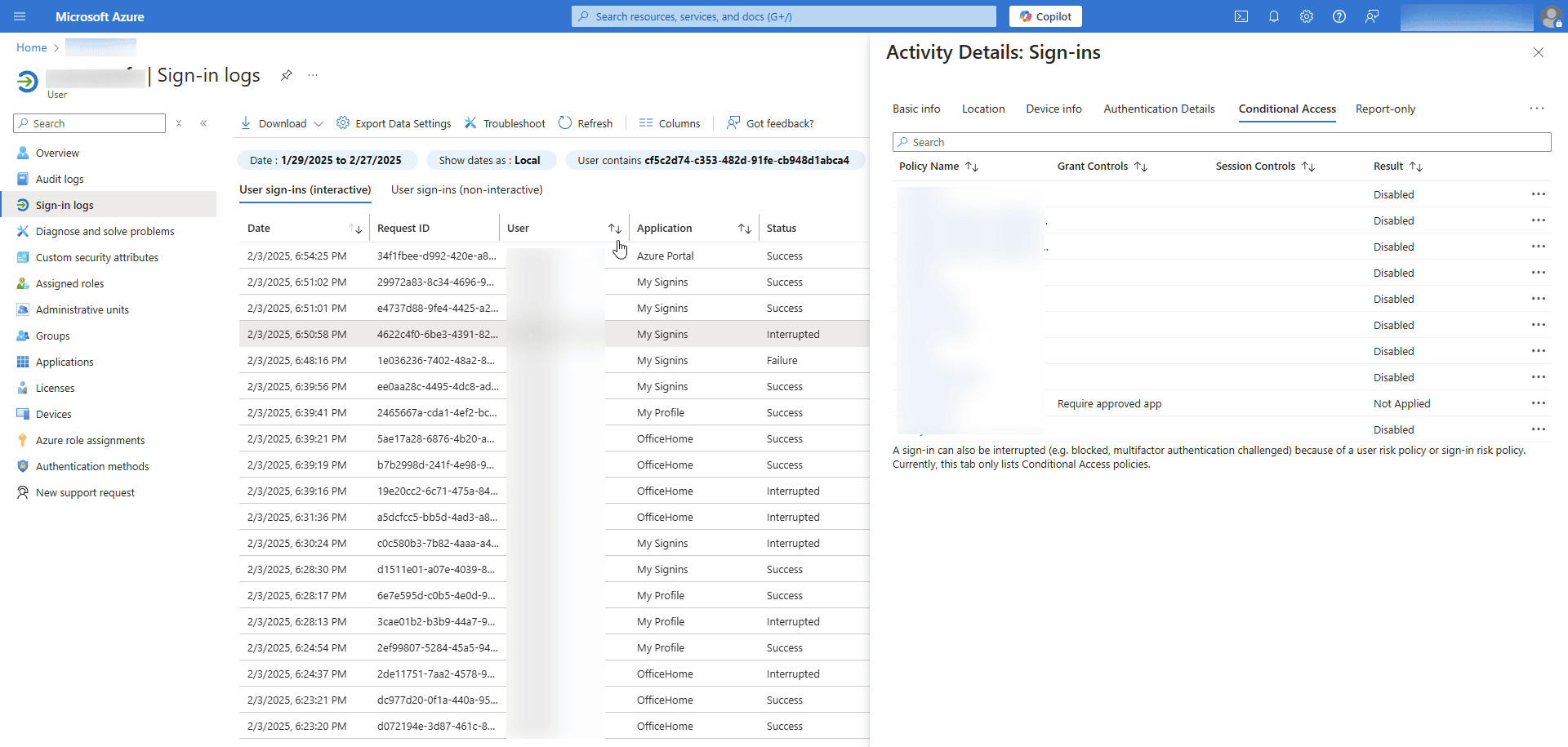
Once you've identified the Conditional Access policy, you can make the appropriate changes to ensure your service account logs in to Microsoft Entra ID.
M365 Manager Plus requires specific DLL files located in the <Installation_dir>\lib\native\ExchangeOnlineManagement directory to connect with Exchange Online and collect data. If these files are blocked from execution, M365 Manager Plus will be unable to establish a connection to Exchange Online, preventing all Exchange Online operations.
Cause
The DLL files might have been blocked from being executed by your computer since they were created in an external system.
Solution
You will have to unblock the DLL files so they can be executed in your server. You can do this by running the following script in Windows PowerShell as an administrator: dir "<Installation_dir>\lib\native\ExchangeOnlineManagement" | Unblock-File
You can verify if the files have been unblocked by following the steps given below:
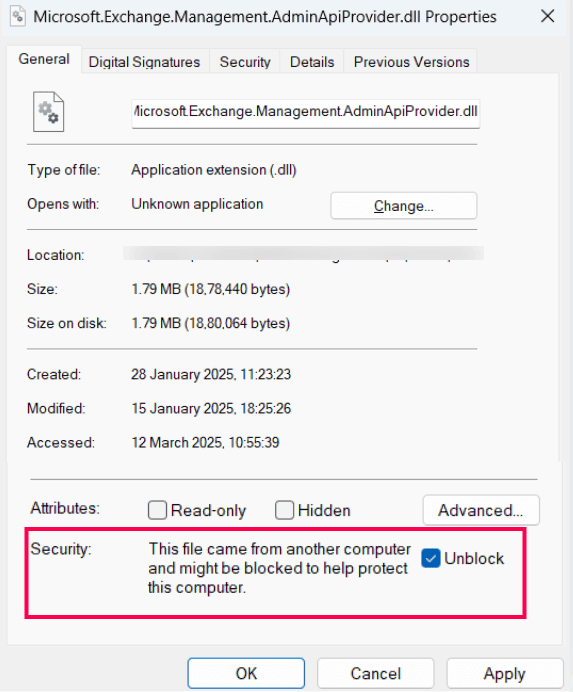
M365 Manager Plus uses an Entra application to obtain permissions and tokens for admin tasks via GraphAPI. Registering the Entra app grants the tool access to read or manage tenant resources. You must create a client secret to authenticate securely during the OAuth 2.0 flow. Without this secret, Microsoft 365 cannot confirm the app’s identity or authorize its actions.
However, in some cases, you cannot create a client secret in your tenant due to a restriction in your tenant-wide policy.
Cause
Your tenantAppManagementPolicy might be configured to restrict creating new client secrets for Entra applications in your tenant. Refer to this Microsoft document for more details on this policy,
Solution
You will have to edit the passwordAddition attribute in your tenantAppManagementPolicy using Microsoft GraphAPI to allow creation of client secrets in your tenant.
Cause: The MFA Status report could not be generated because the Entra application registered in M365 Manager Plus does not have either the Privileged Authentication Administrator or Global Reader role.
Solution: Assign either of these roles to the Entra application registered in M365 Manager Plus by following the steps listed here and try again.
Appropriate scopes must be assigned to perform this task. Click here to know the required scopes.
When REST API is enabled appropriate roles are required for the Azure application to perform privileged operations like Reset password, Block/Unblock users, Change authentication information, Delete user, Restore user and Hard delete user.
Helpdesk Administrator role should be assigned to allow technicians to update details of non-administrators and other help desk administrators.
Privileged Authentication Administrator or Global Administrator role should be assigned to allow technicians to update details of all users (administrators and non-administrators).
Appropriate role must be assigned to perform this task. Click here to know the steps to assign the same.
Contact your administrator.
Kindly refer the below table and take necessary actions while invalid argument error is thrown when a management task is performed.
| Operation Title | Roles required | Action to be done |
|---|---|---|
| Microsoft 365 Group Modification | Security Group Creation and Membership role | In Exchange Admin Center, please make sure that the service account is part of Organization Management role group which has Security Group Creation and Membership role. |
When a new object is created, it will take some time for it to sync to Azure AD. Any management task that is to be performed on the newly created object will fail as the object will not be found. In this case, M365 Manager Plus will schedule those tasks to be executed after one minute. If that fails, it will be scheduled to be executed five minutes later. A list of these tasks can be found by clicking the Delayed Tasks button on the top-right corner of the Management tab.
Cause:
This error occurs in the Create Bulk Guest Users task, when:
Solution:
Cause
This error occurs in automation tasks that use the entries in a CSV file to import the objects for the required task and have the Select only the appended objects option checked. This occurs when the automation task could not find any new entries in the CSV file that were not processed earlier. This could be because no new entries were added, or there might be a problem reading them from the file.
Solution
This error occurs when selecting multiple objects in any of the following management tasks:
Causes
Solutions
Cause:
This error message appears if you attempt to run the MFA Settings management task without configuring a service account that has the Privileged Authentication Administrator and Global Reader roles assigned to it.
Solution:
You will have to create a service account in Microsoft 365 with the required roles and configure it in M365 Manager Plus.
An Administrator has changed the password to your Microsoft 365 account.
Login to Microsoft 365 Portal and reset your password to login to ManageEngine M365 Manager Plus
Rest API based authentication must be enabled for MFA-enabled / Federated Help Desk Technician accounts.
Once enabled, users with MFA-enabled / Federated Accounts will be redirected to Microsoft 365 portal for authentication to access M365 Manager Plus.
Click here to enable Rest API based authentication
The error occurs when a PSSession can not be opened successfully.
Make sure that you have entered the correct user name and password.
If the problem still persists, contact your administrator.
Make sure that you have entered the correct user name and password.
If the problem still persists, contact your administrator.
Make sure that the product is running in the standby server.
Ensure that firewall is disabled for the port in which the product is installed.
The storage space of the drive in which the product is installed is insufficient to complete the migration. When you increase the storage space and restart the product, the migration will restart automatically.
The storage space of the drive in which the product is installed is insufficient to complete the migration. When you increase the storage space and restart the product, the migration will restart automatically.
If disk space is low(<1 GB), please free up some space and restart the product
If disk space is high(>1 GB), please contact m365securityplus-support@manageengine.com .
If the problem persists, contact m365managerplus-support@manageengine.com .
This problem occurs when the DNS associated with the machine running M365 Manager Plus does not contain the necessary information. You need to add the DCs manually.
This error could be due to any of the following reasons:
This error could be due to any of the following reasons:
This error message will be displayed when Elasticsearch bundled with the product has stopped unexpectedly.
This may be due to any of the following reasons:
Cause 1: Insufficient disk space
It is advised to have at least 1GB of free disk space for Elasticsearch to function effectively. When the size of data stored in Elasticsearch increases, it is recommended to free up storage accordingly to ensure Elasticsearch functions as expected.
Solution:
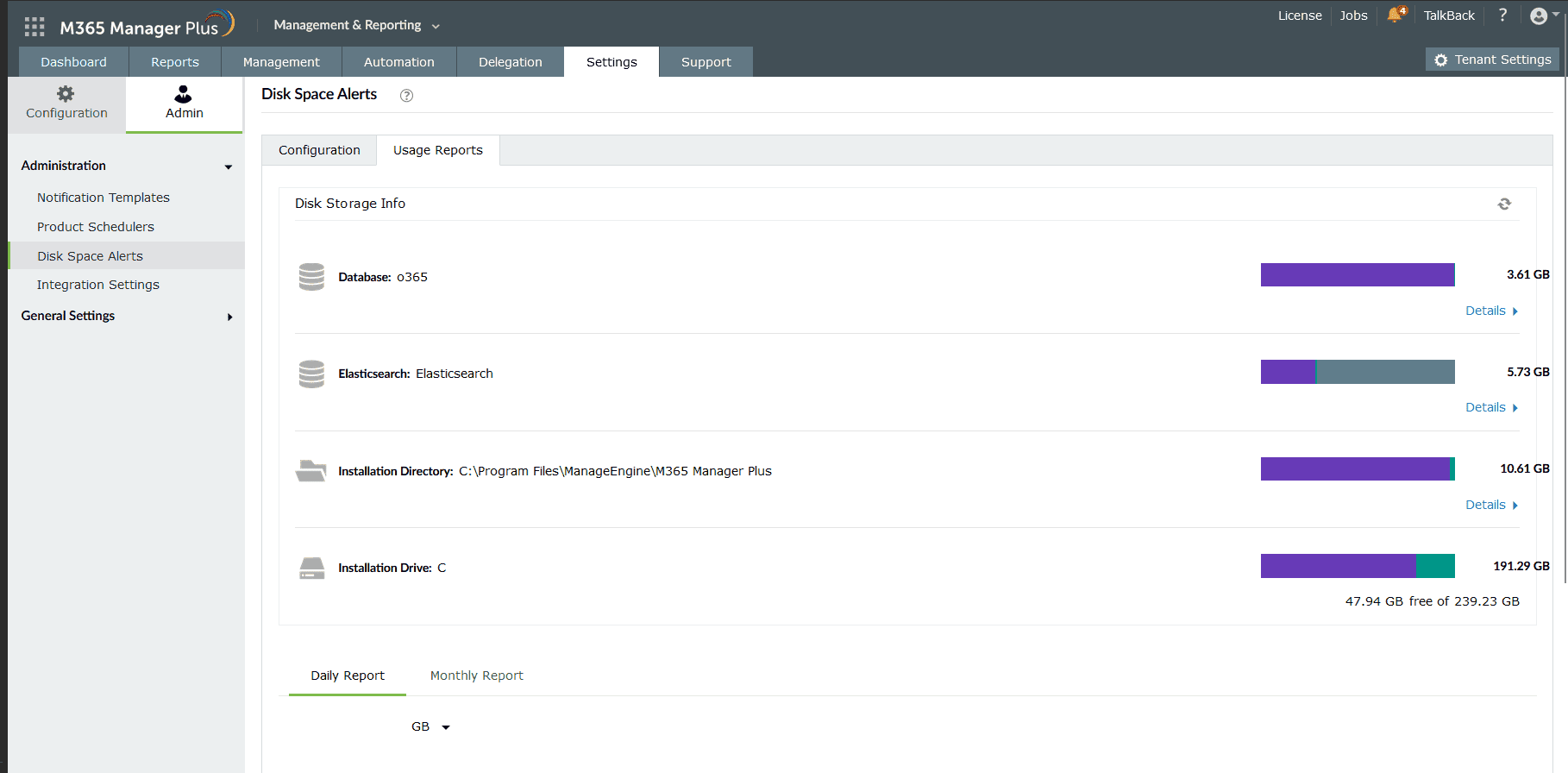
Cause 2: Insufficient heap memory
Elasticsearch uses a file-system cache to provide faster searches. It is recommended to have at least 30% of the server's RAM free for Elasticsearch to use. This free RAM will be used to cache Elasticsearch's indices to provide better performance.
For proper functionality, 2GB of heap memory is initially assigned to Elasticsearch. When the size of data stored in Elasticsearch increases, it is recommended to assign more heap memory accordingly. At least 1GB of heap memory for every 60GB of data stored in Elasticsearch is required.
Solution:
You can assign more heap memory to Elasticsearch (1GB for every 30GB of Elasticsearch data is recommended for better performance) if it is feasible to do so.
To configure the heap memory assigned to Elasticsearch, follow the steps below.

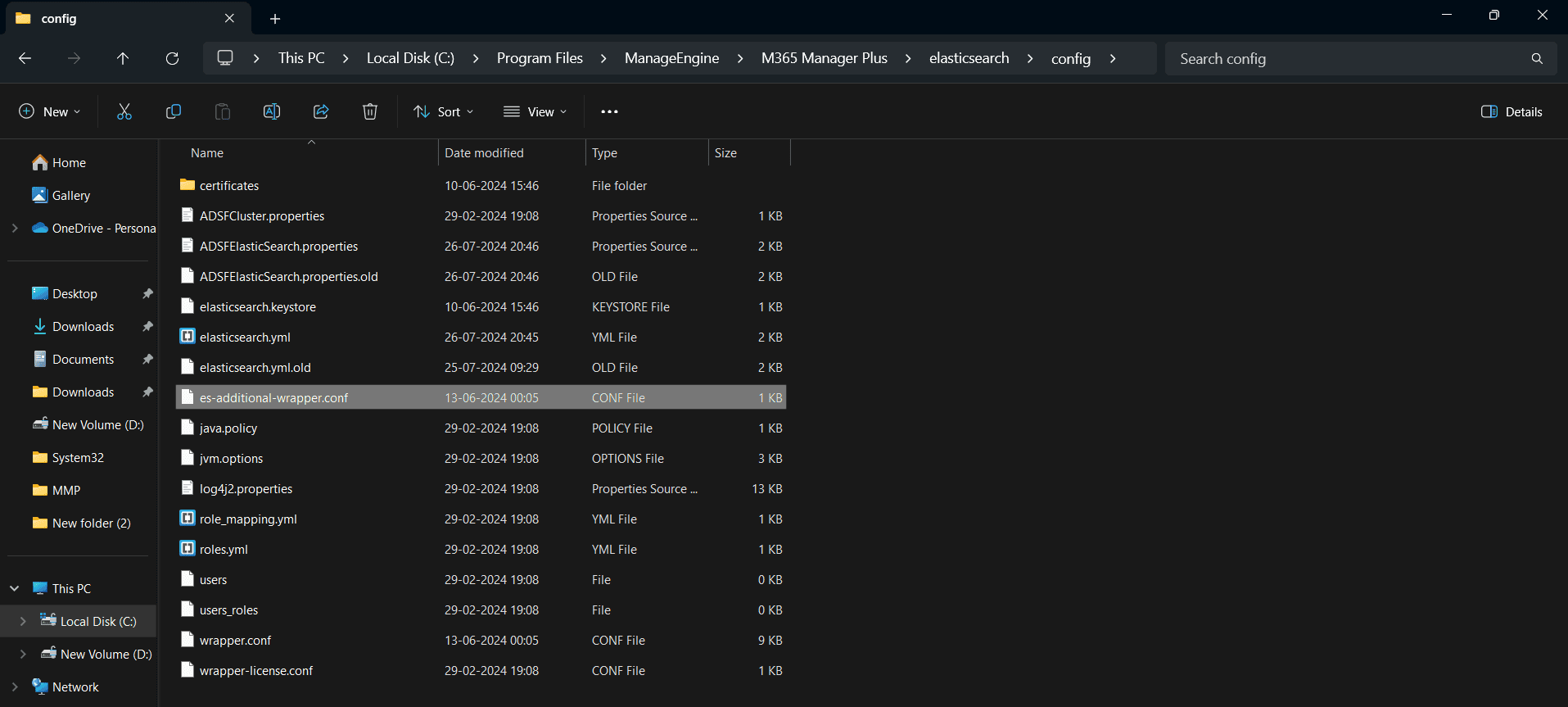
Note: Make sure you back up a copy of the es-additional-wrapper.conf file before making any changes so that you can restore it if you encounter any issues while configuring the heap memory assigned to Elasticsearch.

Note:
Cause 3: Firewall ports 9300 to 9400 have been blocked
To allow Elasticsearch to interact with Microsoft 365 and collect data, firewall ports 9300 to 9400 are used.
Solution:
If these steps did not resolve your issue, please contact the support team at m365managerplus-support@manageengine.com to get it resolved.
Cause:
This error occurs in instances where Microsoft SQL Server is configured as the product database. A transaction log that records all transactions and modifications made by each operation is maintained in the database. When the log size reaches the allotted size limit, all transactions in the database will be stopped.
Solution:
To resolve this issue, enlarge the transaction log size or optimize the log file growth by following the steps mentioned in this article.
Cause:
M365 Manager Plus users updating to build 4800 will have the product's built-in PostgreSQL database updated to version 15.7. In this case, you will be required to free up more disk space (1.3 times occupied by your product database) to proceed with the update. This space is only required for migrating the database from the old version to the new version. It will be freed up once the update is complete. Follow the steps mentioned below to find the size of your product database.
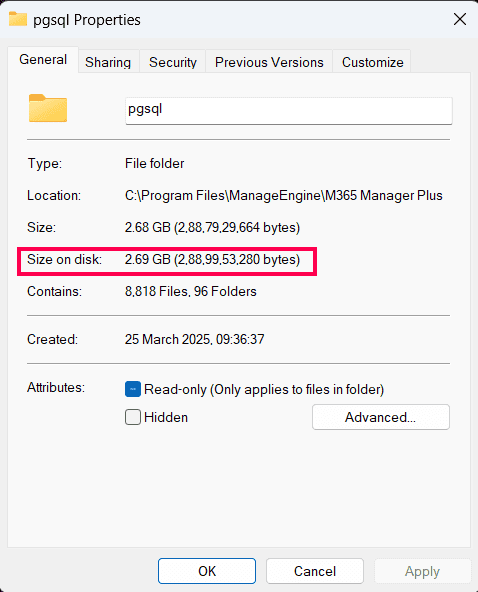
Solution:
This error occurs when the certificate used for authentication firewall or proxy is not trusted by the product's Java Runtime Environment (JRE). To rectify this condition, the certificates must be added to the JRE's trusted certificate store. To locate and import the certificate, follow these steps. To add the certificate to the trust store:
Follow the steps below to identify the certificate to import in the keystore:
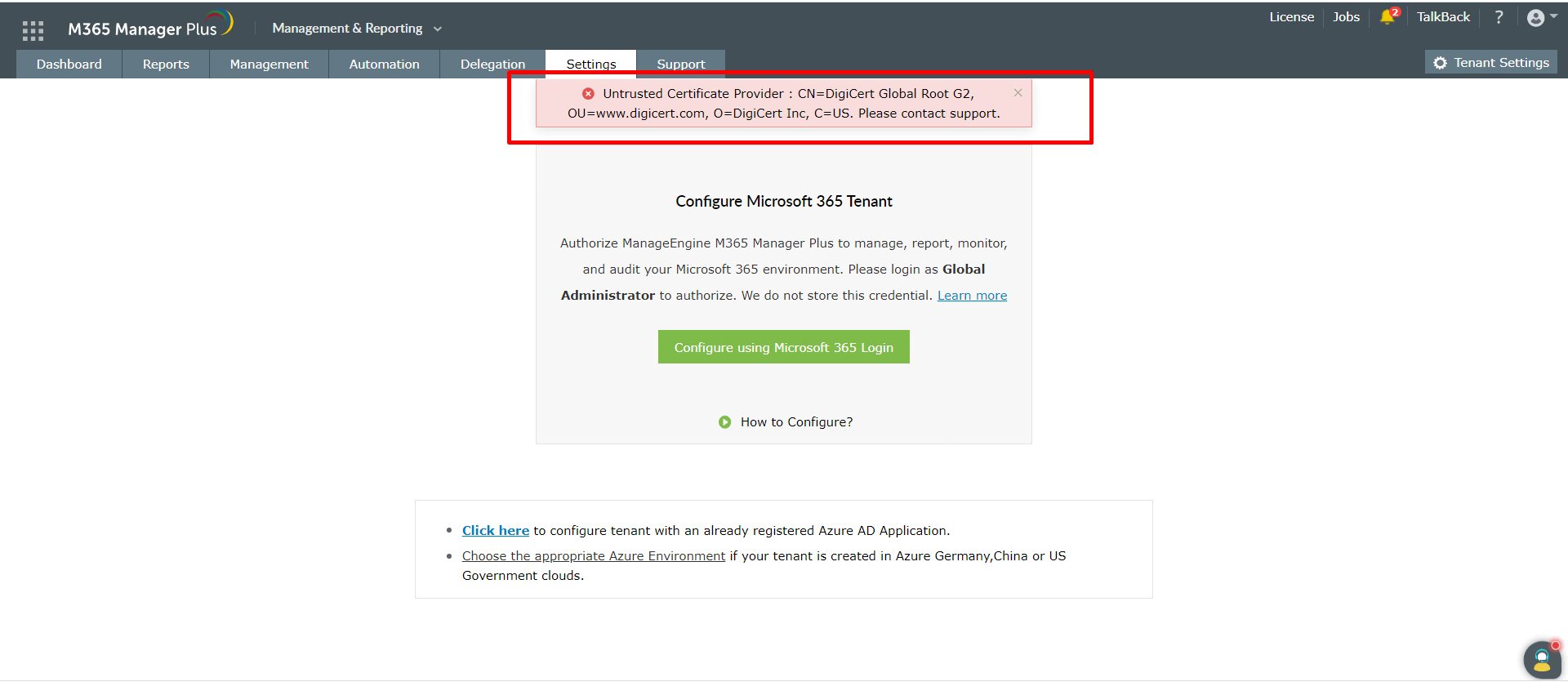
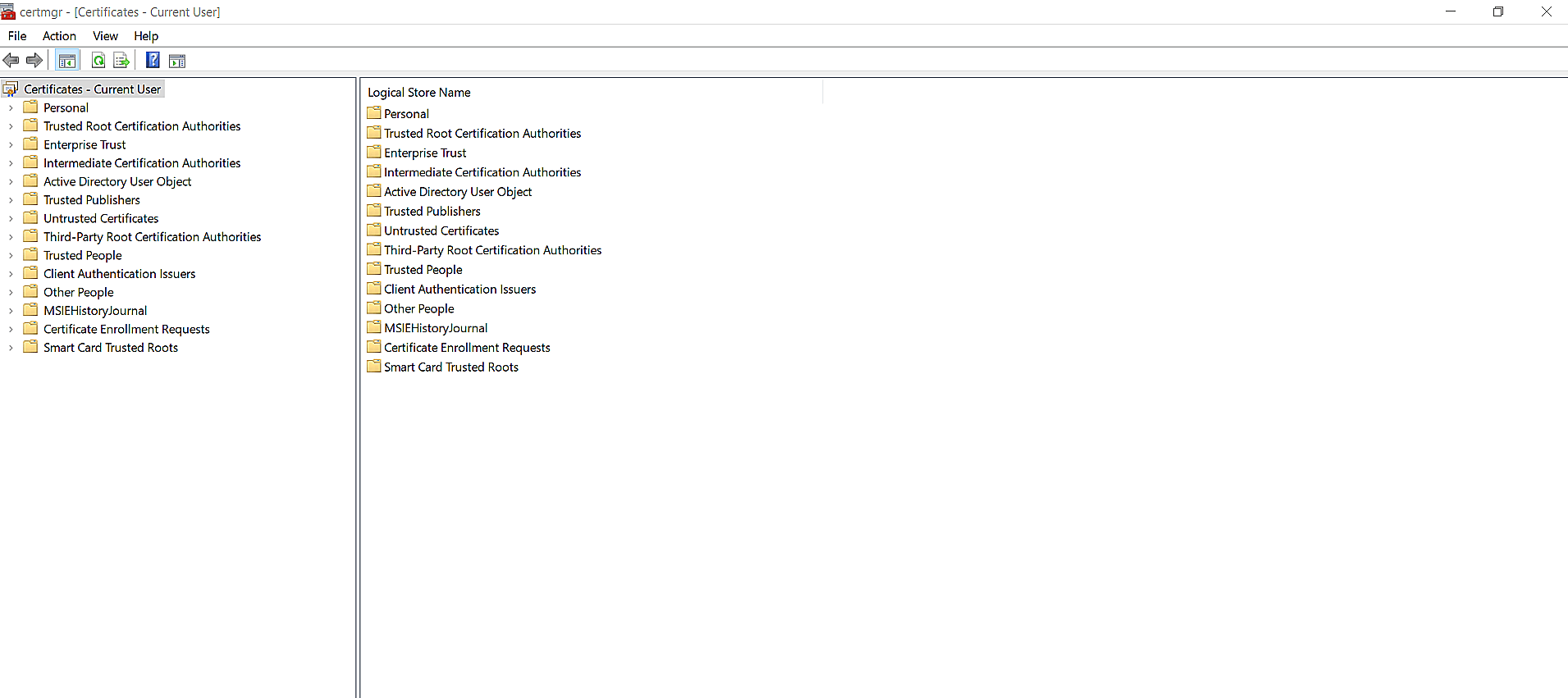
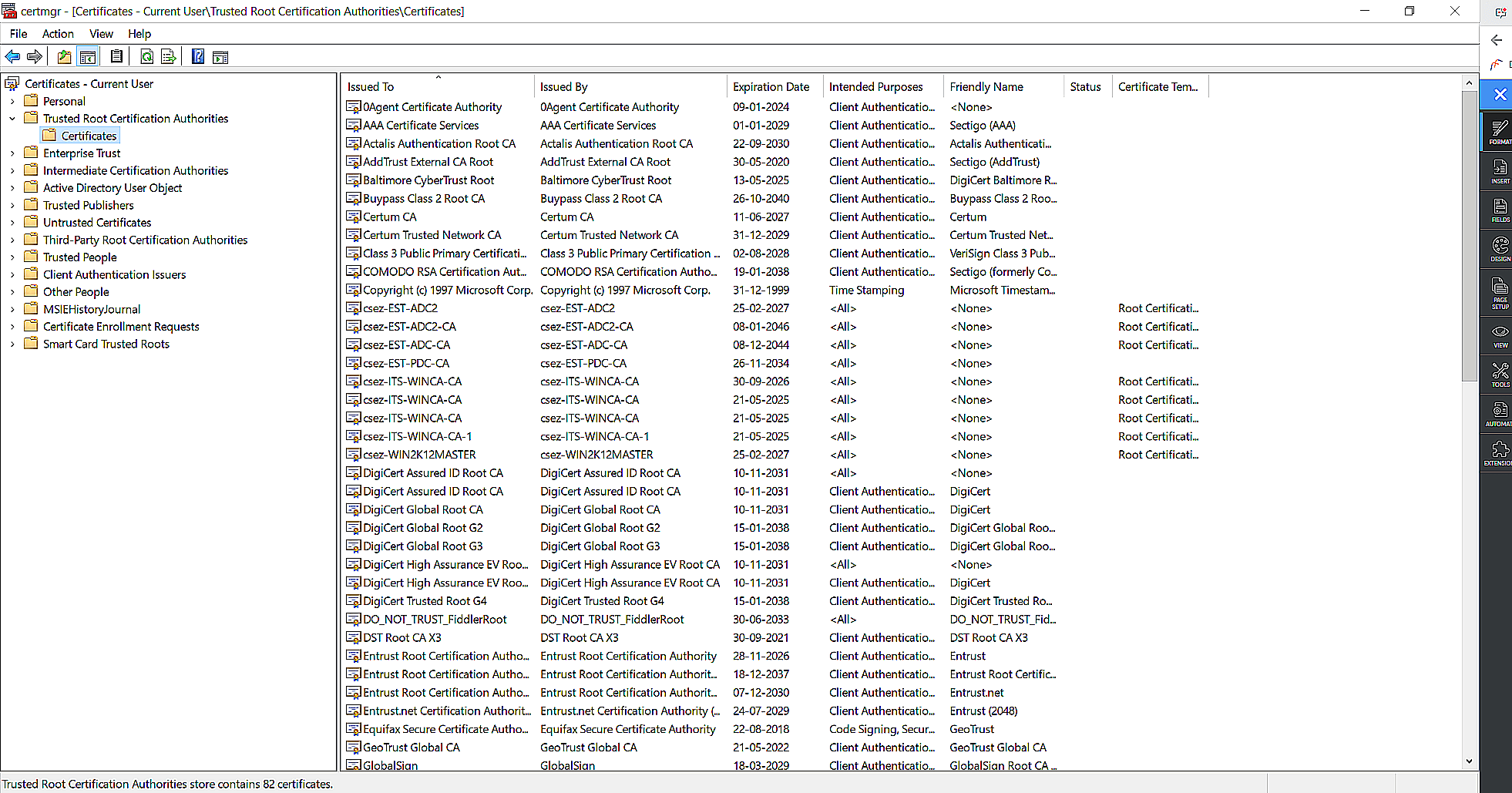
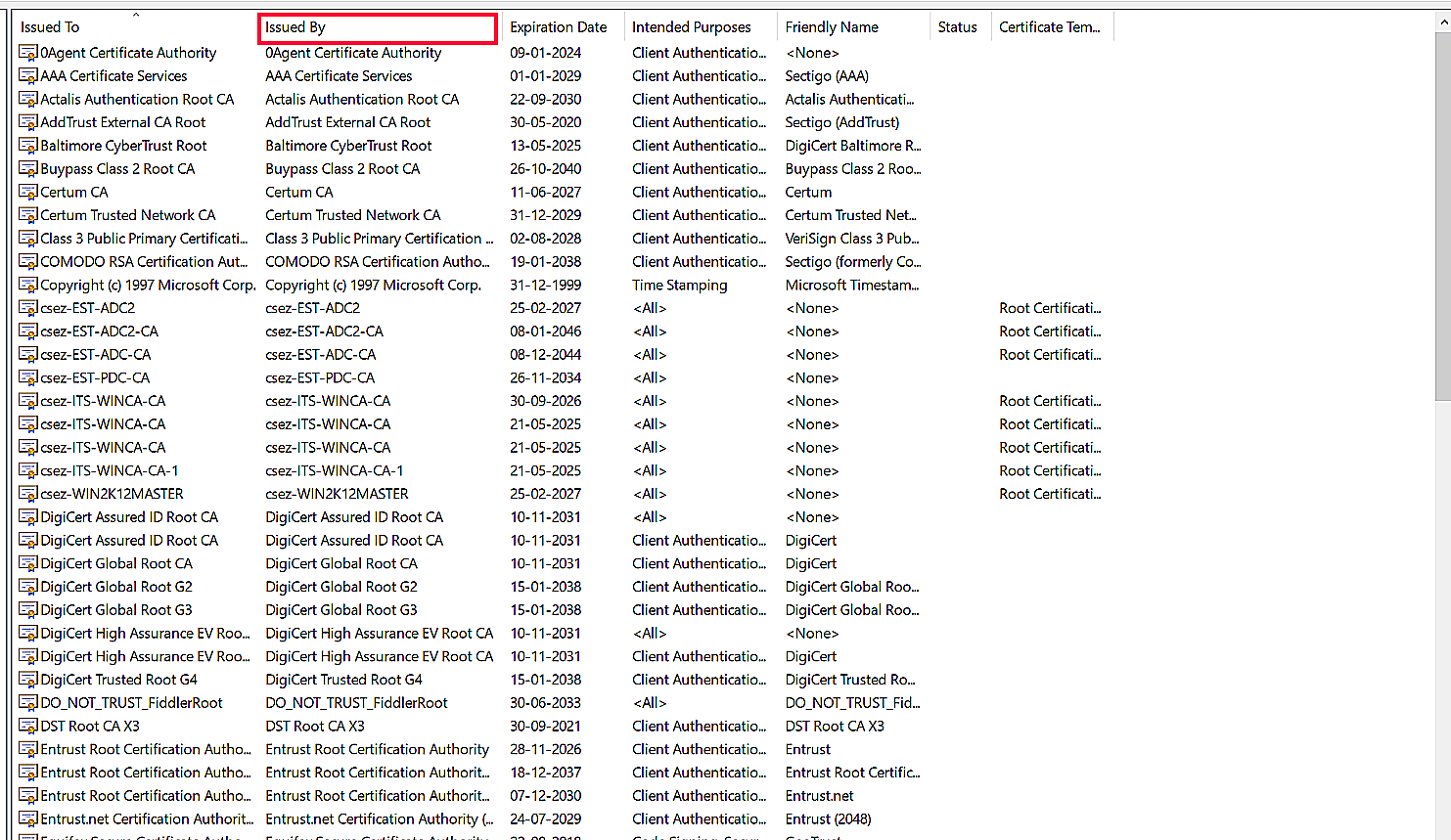
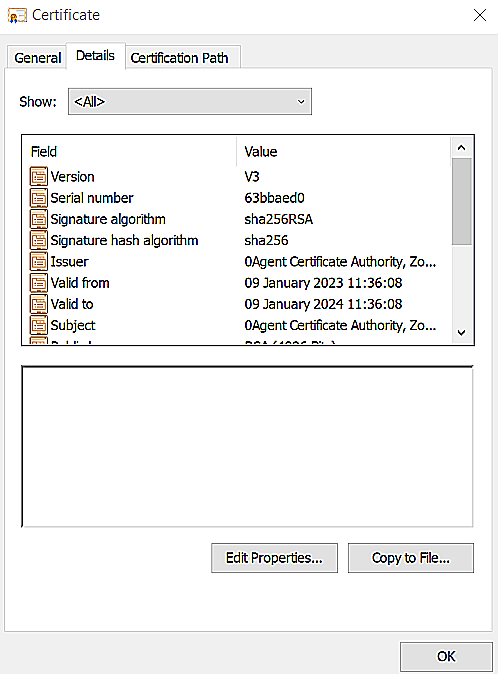
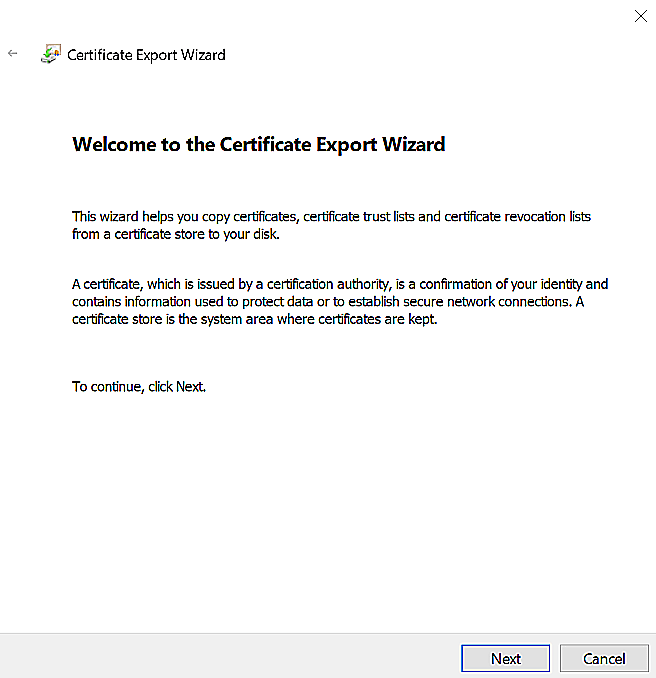
If your service account is disabled for remote PowerShell execution, enable it by running the following command in PowerShell as an administrator:
Cause
Fix
Cause This issue occurs when necessary API permissions were not provided for the application.
Fix

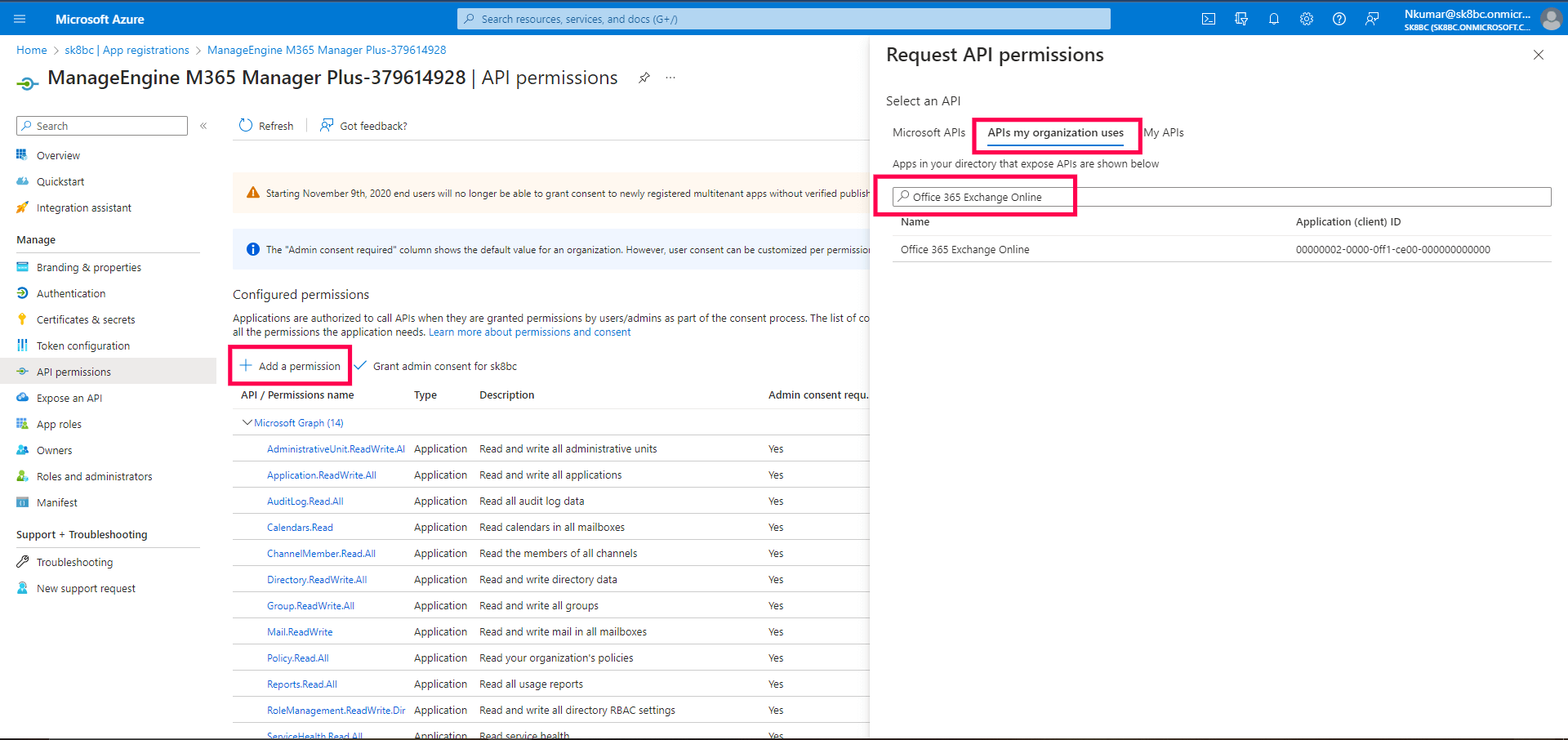
Note: The API permission full_access_as_app uses Exchange Web Services to backup and restore mailboxes.
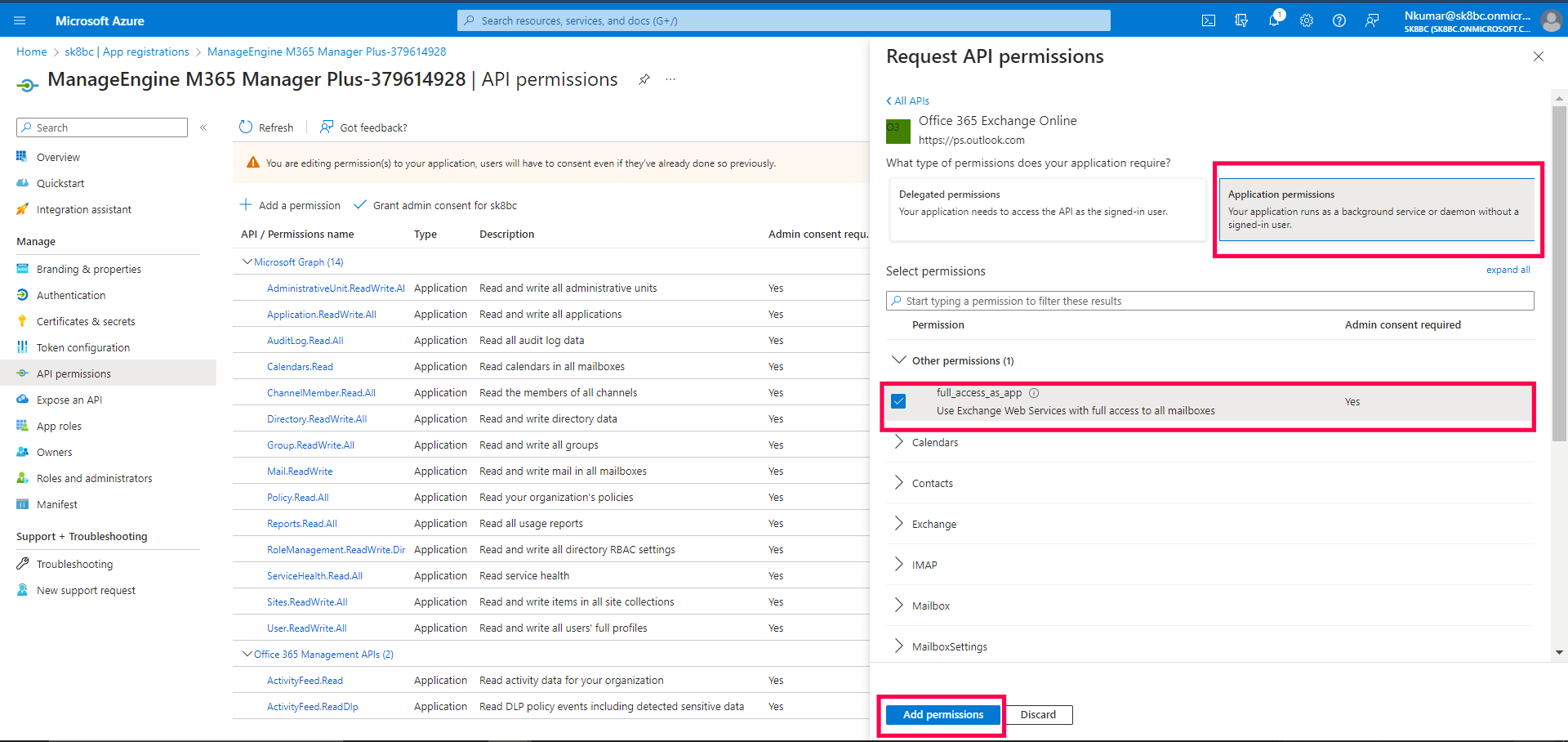
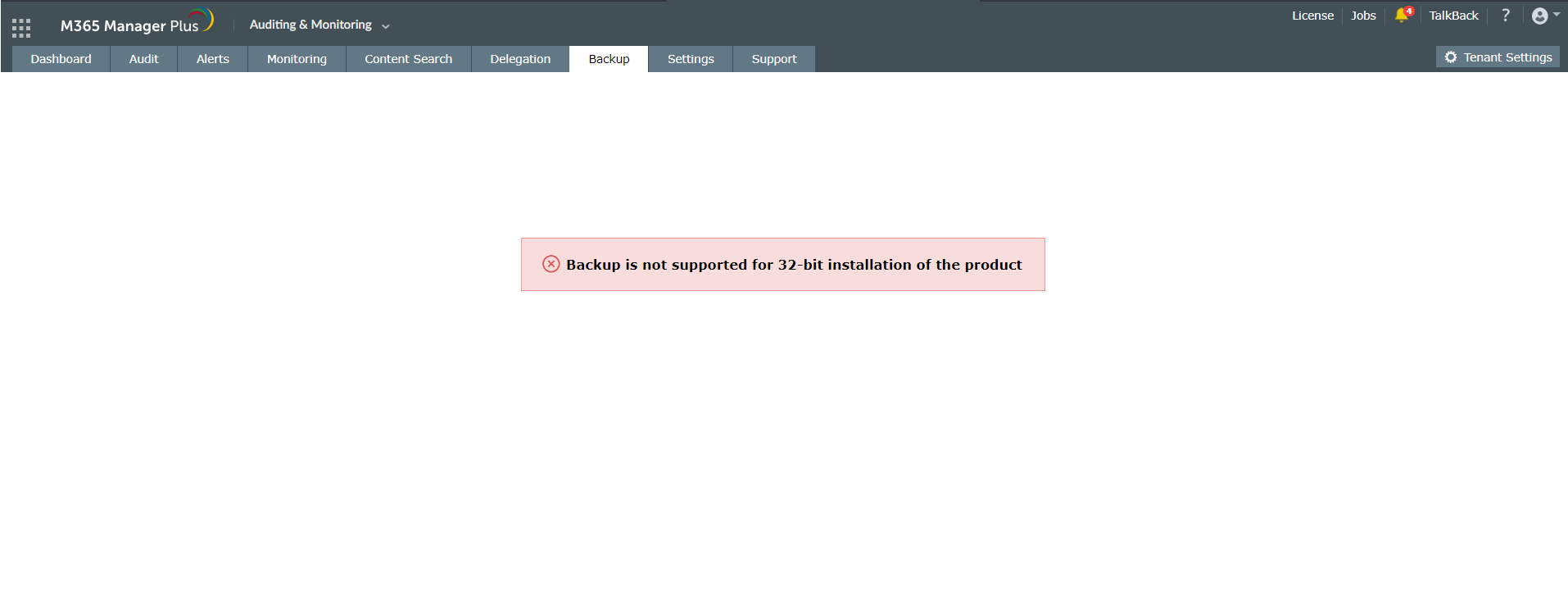
Solution:
If you are using a 32-bit version of M365 Manager Plus, you won't be able to back up data using the add-on. Install the 64-bit version of the product to enable backup.
Steps to install the 64-bit version of M365 Manager Plus
Note: Take a backup of the M365 Manager Plus database before installing the 64-bit version to avoid loss of data.
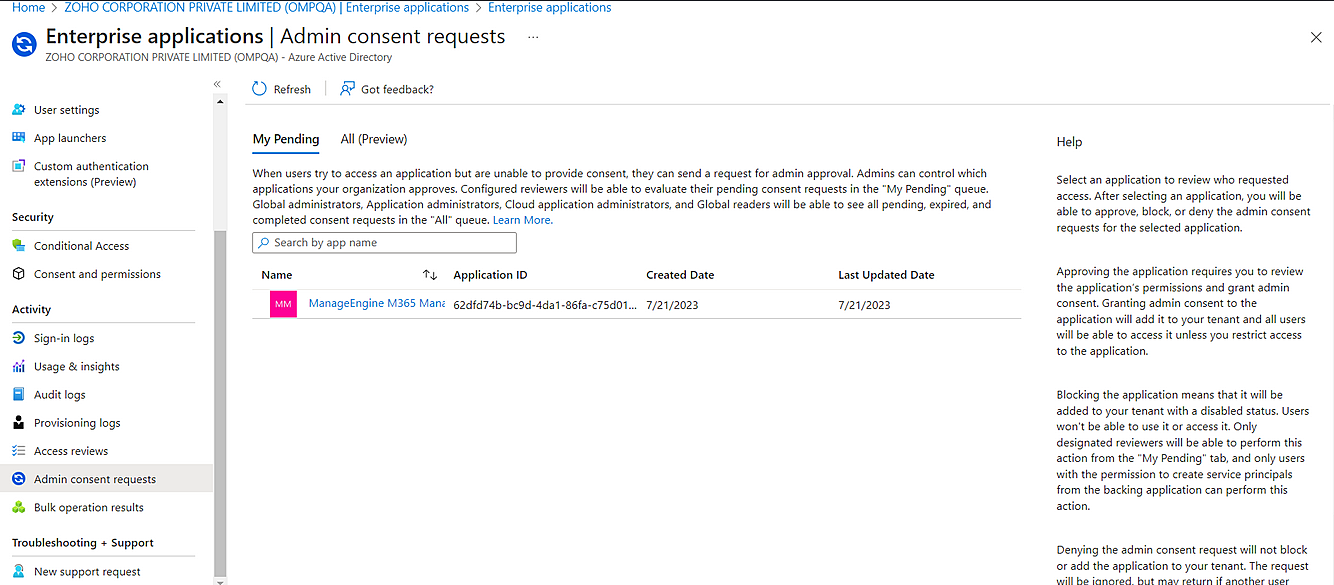
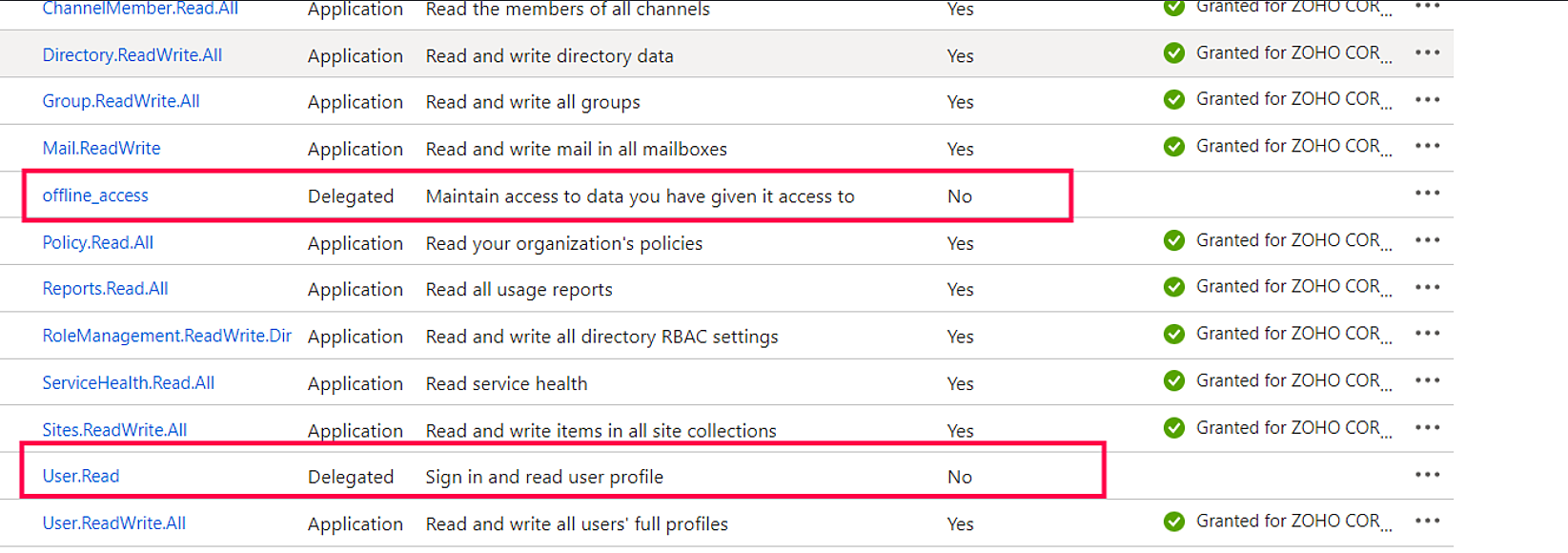
Active Directory users can be added as technicians in M365 Manager Plus and can be assigned any combination of reporting, management, and auditing tasks. When two Active Directory users with the same UPN are registered in M365 Manager Plus as technicians, this can cause an ambiguity in the login process as to which user account should be logged in to.
Cause
When two different users are assigned technician roles in M365 Manager Plus, they will need to have unique UPNs to be configured. Once they are added, if their UPNs are edited to be the same, this can cause the error to surface.
Solution
Copyright © 2023, ZOHO Corp. All Rights Reserved.